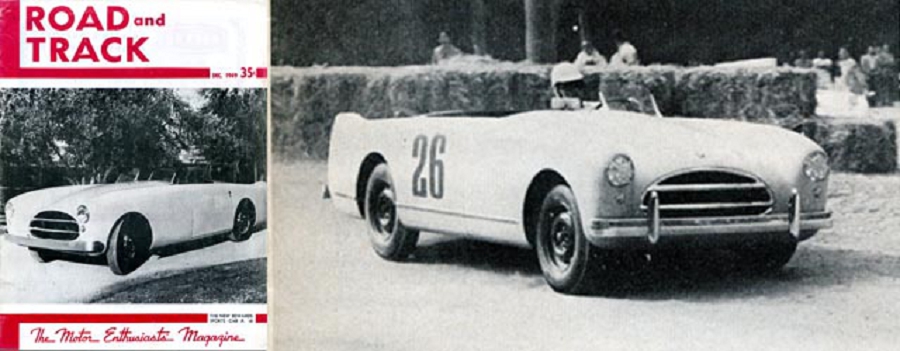
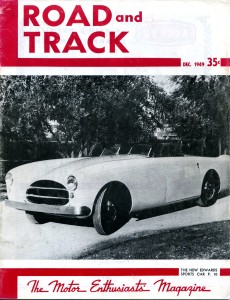
The Edwards R-26 Was Newly Minted And Already Was Featured On The December 1949 Issue of Road & Track – The Sixth Issue of R&T Ever Printed.
Hi gang..
“Consider….the Edwards R-26 Special wasn’t an obscure, little known sports car. In fact, it’s probably the most famous, best known, and most important pure bred American sports and race car built in the early postwar era.”
Read on to discover why…
Postwar Chronology of Automotive Racing, Sports Car, And Custom Car History:
The more I study the Edwards R-26 sports car, the more I’m intrigued that it has received only modest attention over the years.
I’m more of a “sports car” than a “race car” car guy but like many early postwar sports cars – the Edwards R-26 is a “race car” too. As a refresher, click here to review the vintage articles I posted last week about the R-26 Edwards Special.
Postwar automobile racing was about to explode across the country in the late 1940’s. Legendary races such as Bridgehampton and Watkins Glen started up in the East, while road racing began with a modest event in 1949 at Buchanan Field on the West Coast.
And these facing facts come from new friend, David Seielstad. David has helped me understand the major races in the early postwar era, and the importance of each. Let’s review the timeline in the postwar era a bit – including some of the major postwar race events:
———————
1945:
- End of World War II
———————
1946:
- Bill Burke creates first belly tank streamliner (later called the “lakester) on the salt flats
- Indianapolis 500 race resumes
———————
1947:
- “Sport Custom” coachbuilt cars begin to appear. These are cars that share both sport car and custom car heritage, some of which include the 1947 Huth Custom Cadillac and ’47 Kurtis Omohundro Comet
- Dan Post first to document building of American Custom and “Sport Custom” cars in his first of a series of Custom Cars Books that spanned from discussions in early 1944 thru full-fledged books in 1955.
- May 1947 1st issue of Speed Age Magazine
- June 1947 1st issue of Road & Track Magazine
—————-
1948:
- More sport custom coachbuilt cars continue which include the second Kurtis Omohundro Comet and the Kurtis Buick Speedster
- Attempts at production sports cars begin in 1948 which include the Davis, Fergus, Gadabout, Playboy, Tucker, and later the Yank – in 1950.
- First East Coast Race debuts: Watkins Glen, New York – the first major road in the Northeast and first SCCA race in America.
- January: 1st issue of Hot Rod Magazine
—————–
1949:
- The Norman Timbs special – a “Sport Custom” was designed and built.
- The Edwards R-26 debuted in late Fall 1949 – the first coachbuilt dual-purpose sports car / race car built in postwar America
- Three East Coast Races completed: Watkins Glen (NY), Bridgehampton (NY), and Linden Airport Road Raceway (NJ)
- First West Coast Race debuts: Buchanan Field, California – first postwar sports car road race in California
- The Kurtis Sports Car (KSC) debuts – the first small-scal production American sports car – some were raced too (about 20 were made).
- First Nascar Race held at Charlotte Speedway, North Carolina
- January: 1st issue of Motor Trend
—————–
1950:
- First Palm Springs Road Race – first major sportscar road race in postwar on West Coast
- First Pebble Beach Road Race completed
- Second Buchanan Field Road Race completed
- First 6-hour at Sebring (December, 1950)
- Cunningham C1 debuted in late 1950 – the second coachbuilt dual-purpose sports car / race car built in postwar America
- First Pebble Beach Concours d’ Elegance
—————-
What a cacophony of activity! Can you imagine having a ringside seat to all of this that was happening? Well Sterling Edwards did, and he had the insight, enthusiasm, talent, and resources to do something about it. He set about building his own dual-purpose sports and race car – and making history in the process of doing so.
Let’s take a look at what he accomplished starting in the late 1940s.
Detailed Race History of the Edwards R-26:
When we started conversing, David Seielstad schooled me on the following pertinent facts concerning Sterling Edwards:
“Hi Geoff…Did you know that Edwards invented the Pebble Beach races and the Pebble Beach Concours d’ Elegance in 1950? He also organized the first Palm Springs races (April 16, 1950), and in 1950 he raced in four events on the West Coast and won three. David”
Wow!
He won the first 3 times he entered race in Palm Springs, Buchanan Field, and Pebble Beach – pretty impressive. And won “Best of Show” at the first ever Pebble Beach Concours d’Elegance too – an event that he help create in California.
The following information is from David Seielstad’s work, and I very much appreciate his taking the time to complete this history. This is a work in progress and David Seielstad and I will work toward refining this list to support a complete racing history of the R-26 as we move forward.
(Note: The history below also includes the rebodied R26 car when it carried a Haggeman aluminum body in its secord iteration. Also shown is a third Edwards race car – the R62 – which is a fiberglass bodied Chrysler powered race car. This list below is a “work-in-progress.”)
——————-
1950:
- Race 1: April 16, 1950: Palm Springs. R26 main 1st place. This was the second major auto race in postwar California. The Buchanan Field race in ’49 is considered the first.
- Race 2: May 21, 1950: Buchanan Field. R26 main 1st place. This was the third major auto race in postwar California.
- Race 3: Nov 5th, 1950: Pebble Beach. R-26 entered 2 of the 4 races that weekend. R-26 won Del Monte Trophy race, and was 14th in the Pebble Beach cup race (main race). This was fourth major auto race in postwar California, and was the first running of Pebble Beach auto race in 1950. This was also the first year for the Pebble Beach Concours d’ Elegance and the R-26 won “Best of Show” there too.
- Update 10/20/2011: From Mike Jacobsen: Hi Geoff: Good work! You missed Edwards’ second race: Santa Ana, June 1950, where he finished fourth or fifth I think. It was the first I attended; Richter won in an Allard, Hill second in XK 120. Mike Jacobsen

Caption: Sterling Edwards – Edwards Sports Car 1st – Del Monte Trophy. (Road & Track, January 1951).
——————-
1951:
- Race 1: April 1st, 1951: Palm Springs. R-26 DNF drive shaft then lost water and engine seized. Noted that it was running Ardun heads.
- Race 2: May 27, 1951: Pebble Beach. R-26 entered again 2nd in Del Monte Handicap. Drove(?) in Pebble Beach Cup. Not mentioned in results
- Race 3: August 5, 1951 Buchanan main #26 R26 DNF
- Race 4: October 21st, 1951 Reno #? R26 3rd
- Race 5: October 28, 1951 Palm Springs DNA?
- Race 6: December 9, 1951 Torrey Pines not on entry list or mentioned in reports
——————-
1952:
- Race 1: March 23, 1952 Palm Springs #? Overhead valve V8 60 so R26 DNF
- Race 2: April 20, 1952: Pebble Beach. Debut of R62 #1 and R26 #26 also entered. R 62 based on Henry J and fabricated components. Powered by modified Chrysler 5510 cc engine and carries a fiberglass body. Sterling Edwards was down to drive each of them. Novice Race class 4 (1900-3000cc) T.H. Reidy 2nd #26 R26. Del Monte Trophy Class 1 (5500-8000 cc) Edwards 2nd #1 R 62. Overall he is not listed in first 11 so may have been 15th in Main with R 62. In 1952 Sterling Edwards entered both R 26 and R 62 at Pebble Beach. Neither one finished and I cannot find any photos. It was the first race for R62.
- Race 3: May 31, 1952 Golden Gate #? R 62 18th
- Race 4: July 20, 1952 Torrey Pines #26(?) R 62 DNF (described as Chrysler engine)
- Race 5: August 3, 1952 Buchanan DNA?
- Race 6: August 24, 1952 Stockton Junior Aid Trophy #26 R 62 Motor Sport World 3rd in report and 5th in chart so ?????. R&T shows 3rd as does SC 11/12 52 pg 11, distant photo pg 10
- Race 7: August 24, 1952 Stockton #26 R62 “Chrysler Special” main 5th. Photo in SC 11/12 52 pg 13 of “Fiberglass R 26” !
- Race 8: November 9, 1952 Madera #26 R?? finish? After this race Sterling Edwards switched to his C Jag then to his Ferraris and did not race an Edwards Sports Car (R-26 or other) again.
——————-
1953:
- Race 1: April 19, 1953 R62 #1 driven by T.H. Reidy Chicago. R26 #27 the first Edwards—now clothed in a cycle fender body and driven by Phil Remington. Results show Del Monte Trophy Barry Wagner 7th in R 26 #27 and T. G. [sic] Reidy 9th in R 62 #1. Edwards drove his new C Jaguar #26 to 5th in the same race.
- In 1953 both Edwards race cars ran at Pebble Beach. Neither one was driven by Edwards. Barry Wagner drove R26 special and T.G. Reidy raced R 62 (in the results page, must be a typo). He is also identified as T.H. Reidy of Chicago in the program. Not sure what the G stands for, but the first initial T matches what you found. Barry Wagner is identified as a San Francisco resident. So far have not found any photos of the cars. However the descriptions of entries states that “R26, the first of the Edwards sports cars—now clothed in a cycle fendered aluminum body.” Phil Remington is nominated as driver.
- Note: So the new body on R 26 appeared a year after R 62 made its debut. Also T.H. Reidy of Chicago seems to be the person you located.
——————-
1954:
- Race 1: April 11, 1954 R 26 #1 driven by Barry Wagner Ferrari 340 #26 driven by Sterling Edwards. Edwards won the Del Monte Trophy in the Ferrari (0350 A) and Wagner was 8th in #1.
- In 1954 the [R26] Edwards Special was entered by Sterling Edwards and driven by Barry Wagner with R62 driven by T.G. Reidy.
——————-
1955:
- Race 1: April 17, 1955 “#1 Edwards Special class D. Driver Barry Wagner of San Francisco. A fiberglass-bodied Chrysler engined Special designed and built by Sterling Edwards.” According the the program description. A photo of #1 shows R 26 with its first body! It also shows Phil Hill in #2 his 250 MM, but he drove Guiberson’s 750 Monza (0510) in the race! The Del Monte Trophy entry shows #1 Edwards Special owned by Barry Wagner as D and 2500 cc so clearly R 26 with second body. Edwards drove his Monza (0428) on #26. Edwards was 2nd and Wagner is not mentioned in the results.
——————-
1956:
- Race 1: April 22, 1956 #26 Edwards Monza (0428). No mention of any Edwards car. Sterling finished 5th in his Monza. Never raced again.
——————-
Why Is The Edwards R-26 Special – So Special?
You have to look at the Edwards R-26 Special and where it was among these events. The Edwards R-26 was completed in the Fall of ’49, ran in 3 events in 1950, and won all 3 of them. And these weren’t small races – these were 3 of the first 4 major automobile road races on the West Coast.
And that wasn’t all.
The R-26 was the Road & Track cover car with lead story in December 1949. It was a feature story in the January 1950 issue of Motor Trend and appeared in a significant article on Sports Cars in the December 1949 issue of Popular Mechanics. And….. on top of these achievements… Sterling Edwards won the first Pebble Beach Concours d’ Elegance with a “Best of Show” award in 1950.
I don’t know how much more successful a car would have to be to achieve legendary status in the golden era of postwar racing in America. To me, this would be akin to winning the “Triple Crown” of horse racing and then changing “venues” and winning the best of another event such as a famous steeplechase. Or perhaps it would have been like Michael Jordan from basketball fame switching to baseball – and achieving stardom there too.
You see…I’m having problems comparing the achievements of Edwards and his R-26 in 1950 because I don’t know if there is good comparison. He may be unique in the American postwar racing and sports car era. These types of achievements may be unparalleled – or at least in postwar automotive history in America.
Briggs Cunningham
David Seielstad also brought up the parallel work and creativity of Briggs Cunningham.
Briggs Cunningham on the East had the same idea as Sterling Edwards had from the West. In fact as David relayed to me, Briggs was working in the racing arena before Sterling, so his interest proceeded Edwards interest by a few years.
During the same timeframe as the R-26, however, Cunningham built his Cadillac Special (Le Monstre) in ‘49 which ultimate debuted in its first race at Le Mans in June, 1950. Cunningham’s car was a dedicated race car, though, and by contrast Edwards had designed and built a stylish car with the dual purpose of sports and race car driving – with potential production plans too.
Later, Cunningham debuted the C1 late 1950 and it WAS a dual-purpose sports car / race car of completely American design, construction, and components. But it did, however, come AFTER Sterling Edwards R-26 debut. Sterling Edwards R-26 Special was first.
Summary:
Consider….the Edwards R-26 Special wasn’t an obscure, little known sports car. In fact, it’s probably the most famous, best known, and most important pure bred American sports and race car built in the early postwar era.
Yes, there may have been other racing cars as famous in the early postwar era, but they represented the best of what the overseas manufacturers had to offer – many times with American power installed and running. Most likely hybrids of American and European expertise.
The Edwards R-26 was different. It was conceived, designed, built, born, raced, and won – all American style. It was, as I believe now by reviewing the facts above, the first and most important pure-blooded American sports / race car in the postwar era.
If we celebrate Lance Reventlow’s Scarab – coachbuilt in America and whose body was built by the same person who built the body of the Edwards R-26 – Emil Diedt – then we should be asking and recognizing what was the first coachbuilt American race car in postwar America? That is, what is the heritage of coachbuilt American postwar race cars like the Scarab?
Answer…it all started with the fully original, all-American made Edwards R-26. His was the first coachbuilt, expertly conceived, ground pounding, Ardun blasting, 4 wheel independent suspension using, race-winning, Pebble Beach Concours d’Elegance “Best of Show” achieving sports / race car in the postwar era.
Hope you enjoyed the story, and until next time…
Glass on gang…
Geoff
Update 10/20/2011: From Michael T. Lynch: William Zimmerman is usually given credit for creating the buck for the first car that Emil Diedt and Lejuie Lesovsky worked from. Michael T. Lynch
——————————————————————-
Click on the Images Below to View Larger Pictures
——————————————————————-
- The Edwards R-26 Was Newly Minted And Already Was Featured On The December 1949 Issue of Road & Track – The Sixth Issue of R&T Ever Printed.
- Caption: Sterling Edwards took Del Monte Trophy Race with ease. (Motor Trend, January 1951).
- Caption: Sterling Edwards – Edwards Sports Car 1st – Del Monte Trophy. (Road & Track, January 1951).
- Photo Of Edwards R-26 From Collection of Peter Boyd – Thanks Peter!
- Best of Show, Pebble Beach Concours d’ Elegance, Sterling Edwards 1950.
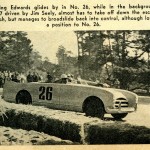
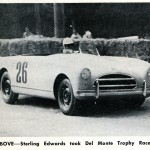
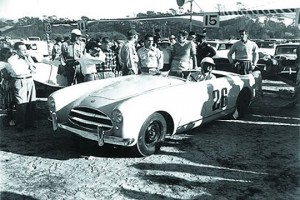
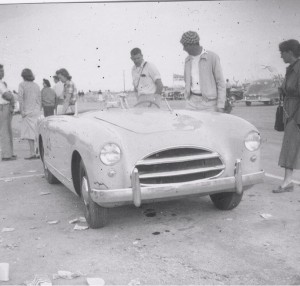


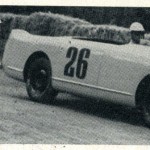
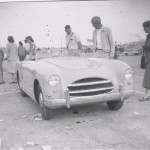
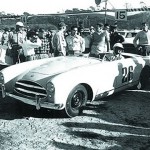

Great read Lee hartung was a great friend to me over the years I have a pic from 2003 of his girlfriend opening the hood of the edwards unfortunately I can’t load it to this site
I heard from the auction company with some more pictures and details of the Jaguar engine in this Edwards. The serial number is W3361-8 with an added letter C after the 8.
The prefix W indicates that it was made for a standard XK120, not a C-type racer (prefix E) or the concurrent Mark VII sedan (prefix A, B or D). The 3361 means it was the 2361st such engine, counting from the first one W1001, so comparing to other XK120s with near engine numbers it probably dates from mid 1951. The 8 means it had 8:1 compression ratio pistons, which were standard in the USA delivered cars, though some countries with poor fuel got 7:1 pistons.
The carbs are standard 1-3/4″ throat SU carbs, standard for XK120. The letter C is not a factory stamping, and guessing what it means is only speculation without a detailed examination of the engine. Possibly it could have been modified for competition with higher lift cams, which were offered by the factory towards the end of 1951 through the dealer network, and the C could be an indication of this, stamped by some unknown mechanic. It is a standard XK120 head, does not appear to be a C-type head. In this standard form it would produce 160 bhp, and with higher lift cams possibly a little more like up to 190 bhp, but not as much as the 210 bhp C-type configuration.
The water pump and fan date from 1952-54. The dashboard gauges are all standard XK120 items. The gearbox appears to be a standard XK120 or Mark VII unit.
The rear axle is not Jaguar. It is an IRS with inboard drum brakes.
After he gave up on this car, for the 1953 season Sterling Edwards bought and raced a couple of C-types, the first of which was crashed, but was repaired, and both survived and are restored classics today.
Rob…Great comments and thanks for sharing your thoughts on the R-26. I’ve been working with a team of folks that has expanded to include other enthusiasts and historians of this era including David Seielstad, Michael Lynch, and Michael Jacobsen. With the help of Phil Remington as well, we should be able to provid an excellent chronology to identify when the first R-26 body was removed and sent to Edwards friend – Hamil Reidy – in the Chicago area. At this time it looks like it was in mid-’52. Sometmie in the latter half of ’52 the body was shipped to Chicago, and it began its new history with Reidy. We’ll be working on the history from ’52 forward in the near future. Currently I’m compliling history of the first chassis when it was sold to its second and subsequent owners. Keep the comments coming and thanks for your insights.
Geoff
The R-26 coming up for auction Nov 5 2011 near Chicago now has a Jaguar XK120 engine installed, as well as a Smith’s tach and speedo commonly used in Jaguars, and possibly a Jaguar 4 speed gearbox, from what I can see in the pictures. This has generated some interest among classic Jaguar owners, and judging by some small details such as the cam covers, carbs, coil and fan blades, I can date the engine to roughly the first half of 1952. So in your efforts to compile the history of this car, it would be worth while to collect any references to installing the Jaguar engine, including after it left Edwards’ ownership.
Great article Geoff. The time table that you put together is a terriffic resource for all of us that share an interest in the history of American Sports and Racing cars of the immediate post war period.
The comments regarding Briggs Cunningham are interesting. I think that Briggs and Sterling approached their ideas from two separate lines so to speak. Having studied the Cunningham Sports Cars, as well as having an article on the topic published in the April 2010 issue of Vintage Racecar Journal, I gather that Briggs was the die hard racer, a patriotic sportsman of sorts, that aimed at the international scene.
For about a decade after the Second World War, there seemed to be this very nationalistic mind set in the sports car racing community. At that point in time, Le Mans was (and still is in my opinion) THE top sports car race in the world. This is why Briggs aimed so true at winning the French 24 hour classic. At that time the biggest races in the US were at Watkins Glen, Elkhart Lake, and Sebring; all of which Briggs used as preparation to take his campaign to the heart of Europe and fight against the best at Le Mans.
I think if Sterling had done the same thing, the R-26 would have gained a higher position in the history books so to speak. While the races on the west coast at the time were professional events, they couldn’t begin to measure up to what Le Mans had become by 1950, as they were only just getting started and organized in California.
I do believe that the history of the R-26 needs to be brought out into the light more for all the same reasons that you’ve stated, as it is a very important piece of American Sports and Racing car history, but the fact that Sterling never fired a shot at Le Mans will mean that the mighty Cunnigham machines will almost always be seen as the quintessential American post war sports racing cars.
WOW! What a history lesson on the genesis of sports, sports/racing, sporting, boulevard sports, and the rest of the interesting cars that have been derived from those early efforts.
It’s incredibly interesting to learn that the same person was involved with the development of the Edwards and the Reventlow Scarab, cars that many would consider to be miles and even generations apart. It’s also more that interesting to learn of the connection of the cars themselves with the emergence of the earliest venues of both sports car racing and Concours show events, two of the activities most of us enjoy the very most of all of the contemporary car hobby activities.
Geoff, you have yet again, helped to connect the dots and tell the stories in such a talented and inspirational manner it’s almost as if we were there, living this unique and important period of early American automotive history. Thanks again for all you do!